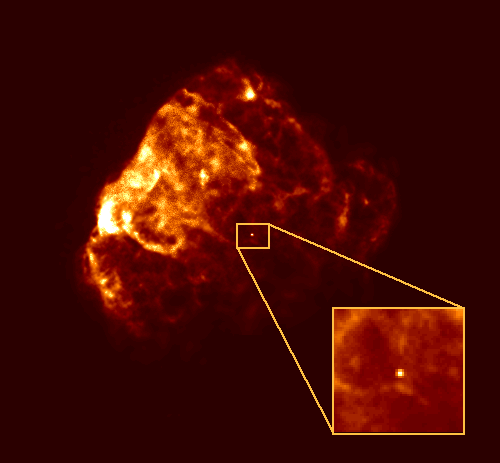Newly Discovered Neutron Star Provides Clues About Stellar Explosions
Astronomers have found a neutron star whose existence and
location provide important new information about how stars
explode. The investigators found the neutron star by detecting its X-ray emission using the High Resolution Imager on board the German/U.S./U.K. Rntgen Satellite (ROSAT). The neutron star is situated near the center of a supernova remnant, the rapidly expanding, extremely hot, gaseous remains of an exploded star. Both are products of the explosion of a very massive star about 4,000 years ago. The supernova remnant, known as Puppis A, is approximately 6,000 light years distant, and is one of the brightest radio and X-ray sources in the sky. Stars with masses more than about 10 times that of the sun end their lives in a spectacular explosion, known as a supernova. This explosion takes place after the star has exhausted the fuel available at its core for nuclear fusion. When the energy produced by fusion can no longer counteract the force of gravity , the first star collapses on itself, and then explodes as gravitational energy is released. This explosion spews out into space in the other layers of the star. These layers are composed largely of elements produced by nuclear fusion, such as carbon, oxygen, neon, and silicon. It also produces a shock wave speeding out ahead of the ejected material, that sweeps up the material around the star, heats it to about 10 million degrees. This material is so hot it is invisible to the naked eye, but glows in X-ray light. Also, depending on the initial mass of the star, the supernova might leave behind the core of the star, altered dramatically by the explosion. One possible form the core can take is a neutron star, a star as massive as the sun, but compressed to a diameter of approximately 20 kilometers (13 miles), and a density comparable to that of an atomic nucleus. Many neutron stars produced in this way are pulsars, sending out narrow beams of radio waves and X-rays. As the star rotates, we observe periodic radio and X-ray pulses as the beam crosses our line of sight. A second possible form for stars larger than about 20 times the mass of the sun, is a black hole. The source discovered in Puppis A manifests many of the properties of a neutron star. It has a temperature of about 3 million degrees, consistent with what would be expected from a neutron star produced the same time as the supernova remnant. Its size, inferred from its brightness and temperature, is also consistent with that expected of a neutron star. Together with what is known from optical studies of the knots of stellar ejecta the presence of a pulsar has revealed important information about the progenitor star. For instance, the atomic composition of the ejecta, as determined by optical measurements, can be compared with theoretical predictions to determine the progenitor mass. For Puppis A, this mass is at least 25 times the mass of the sun. Becker points out, "This is the largest mass progenitor star known with which a neutron star is associated."
Also, by measuring the distance and the direction the knots
move across the sky, it is possible to determine both the
location of the explosion and how long ago it happened. In order for
the neutron star to have reached its present location, it has traveled
at a speed of at least 1,000 kilometers per second (620 miles per
second). While neutron stars associated with several other supernova
remnants seem to be traveling much faster, the one in Puppis A has a
unique aspect. It is traveling across the sky in the opposite
direction from the knots of ejecta. According to Petre, this provides
very strong evidence of an asymmetric supernova explosion. "The
star's outer layers blew off preferentially in one direction, sending
the central neutron star in the other. There is currently no
satisfactory theory that explains how this could happen." "While the X-ray evidence is fairly convincing," comments Petre, "we're missing the one unequivocal piece: a detection of pulsations." Petre promises to undertake further X-ray observations to verify the result and search more carefully for the missing pulsations. Such observations might not be possible until the 1998 launch of NASA's Advanced X-Ray Astrophysical Observatory, the most powerful X-ray observatory ever built. Referring to the fact that the first evidence for the neutron star was discovered while he was carrying out his Ph.D. thesis research fifteen years ago, he added, "I've waited this long to obtain compelling evidence. I can wait a few more years for the clincher."
IMAGES |
By Mission |
Stars |
HEASARC Home | Observatories | Archive | Calibration | Software | Tools | Students/Teachers/Public Last modified: Thursday, 26-Jun-2003 13:48:44 EDT |


